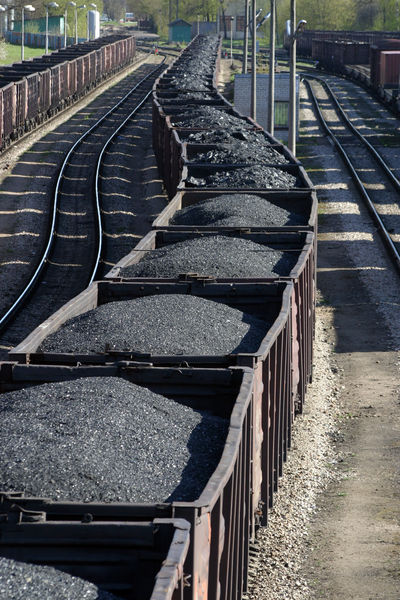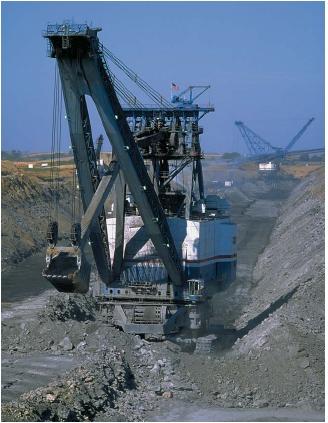Mining

Mining is the process by which commercially valuable mineral resources are extracted (removed) from Earth's surface. These resources include ores (minerals usually containing metal elements), precious stones (such as diamonds), building stones (such as granite), and solid fuels (such as coal). Although many specific kinds of mining operations have been developed, they can all be classified into one of two major categories: surface and subsurface (or underground) mining.
History
Many metals occur in their native state or in readily accessible ores. Thus, the working of metals (metallurgy) actually dates much farther back than does the mining industry itself. Some of the earliest known mines were those developed by the Greeks in the sixth century B.C. By the time the Roman Empire reached its peak, it had established mining sites throughout the European continent, in the British Isles, and in parts of North Africa. Some of the techniques used to shore up underground mines still in use today were introduced as far back as the Greek and Roman civilizations.
Exploration
Until the beginning of the twentieth century, prospecting (exploring an area in search of mineral resources) took place in locations where ores were readily available. During the California and Alaska gold rushes of the nineteenth century, prospectors typically found the ores they were seeking in outcrops visible to the naked eye or by separating gold and silver nuggets from stream beds. Over time, of course, the supply of these readily accessible ores was exhausted and different methods of mining were developed.
Words to Know
Adit: A horizontal tunnel constructed to gain access to underground mineral deposits.
Metallurgy: Science and technology of extracting metals from their ores and refining them for use.
Ore: A mineral compound that is mined for one of the elements it contains, usually a metal element.
Overburden: Rocky material that must be removed in order to gain access to an ore or coal bed.
Prospecting: The act of exploring an area in search of mineral deposits or oil.
Shaft: A vertical tunnel constructed to gain access to underground mineral deposits.
Surface mining
When an ore bed has been located relatively close to Earth's surface, it can be mined by surface techniques. Surface mining is generally a much preferred approach to mining because it is less expensive and safer than subsurface mining. In fact, about 90 percent of the rock and mineral resources mined in the United States and more than 60 percent of the nation's coal is produced by surface mining techniques.
Surface mining can be subdivided into two large categories: open-pit mining and strip mining. Open-pit mining is used when an ore bed covers a very large area in both distance and depth. Mining begins when scrapers remove any non-ore material (called overburden) on top of the ore. Explosives are then used to blast apart the ore bed itself. Fragments from the blasting are hauled away in large trucks. As workers dig downward into the ore bed, they also expand the circular area in which they work. Over time, the open-pit mine develops the shape of a huge bowl with terraces or ledges running around its inside edge. The largest open-pit mine in the United States has a depth of more than 0.5 mile (0.8 kilometer) and a diameter of 2.25 miles (3.6 kilometers). Open-pit mining continues until the richest part of the ore bed has been excavated.
When an ore bed covers a wide area but is not very deep, strip mining is used. It begins the same as open-pit mining, with scrapers and other machines removing any overburden. This step involves the removal of two long parallel rows of material. As the second row is dug, the overburden removed is dumped into the first row. The ore exposed in the second row is then extracted. When that step has been completed, machines remove the overburden from a third parallel row, dumping the material extracted into the second row. This process continues until all the ore has been removed from the area. Afterward, the land typically resembles a washboard with parallel rows of hills and valleys consisting of excavated soil.
Subsurface mining
Ores and other mineral resources may often lie hundreds or thousands of feet beneath Earth's surface. Because of this, their extraction is difficult. To gain access to these resources, miners create either a horizontal tunnel (an adit) or a vertical tunnel (a shaft). To ensure the safety of workers, these tunnels must be reinforced with wooden timbers and ceilings. In addition, ventilation shafts must be provided to allow workers a sufficient supply of air, which is otherwise totally absent within the mine.
Once all safety procedures have been completed, the actual mining process begins. In many cases, the first step is to blast apart a portion of the ore deposit with explosives. The broken pieces obtained are then collected in carts or railroad cars and taken to the mine opening.
Other techniques for the mining of subsurface resources are also available. The removal of oil and natural gas by drilling into Earth's surface are well-known examples. Certain water-soluble minerals can be removed by dissolving them with hot water that is piped into the ground under pressure. The dissolved minerals are then carried to the surface.
Environmental issues
In general, subsurface mining is less environmentally hazardous than surface mining. One problem with subsurface mining is that underground mines sometimes collapse, resulting in the massive sinking of land above

them. Another problem is that waste materials produced during mining may be dissolved by underground water, producing water solutions that are poisonous to plant and animal life.
In many parts of the United States, vast areas of land have been laid bare by strip mining. Often, it takes many years for vegetation to start regrowing once more. Even then, the land never quite assumes the appearance it had before mining began. Strip mining also increases land erosion, resulting in the loss of soil and in the pollution of nearby waterways.
[ See also Coal ; Minerals ; Precious metals ]
And that brings me to my only concern about your website--no bibliography is included in the articles.
Thank you,
Daphne Hayer. Media Coordinator
North Albemarle School
1121 Austin St.
Albemarle, NC 28001